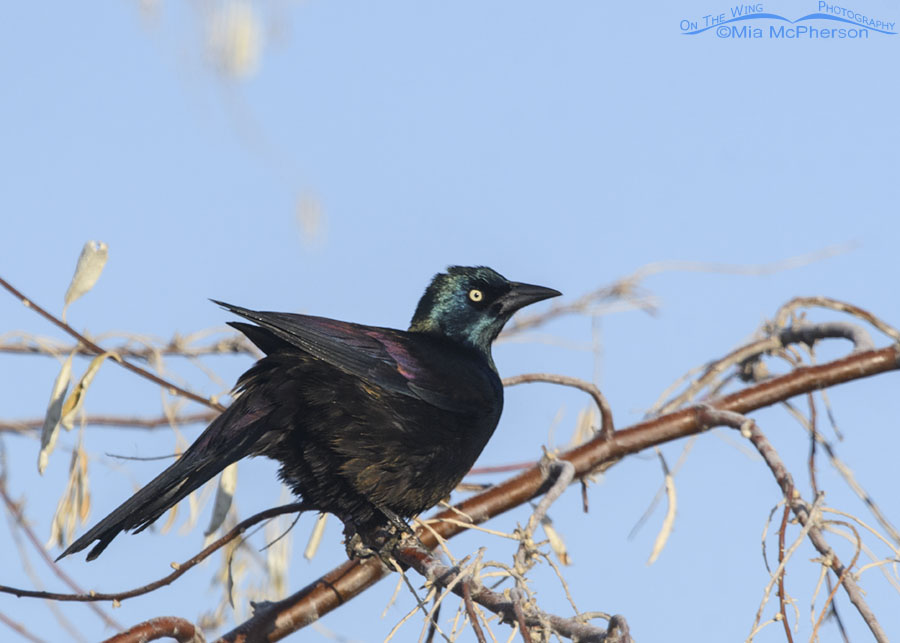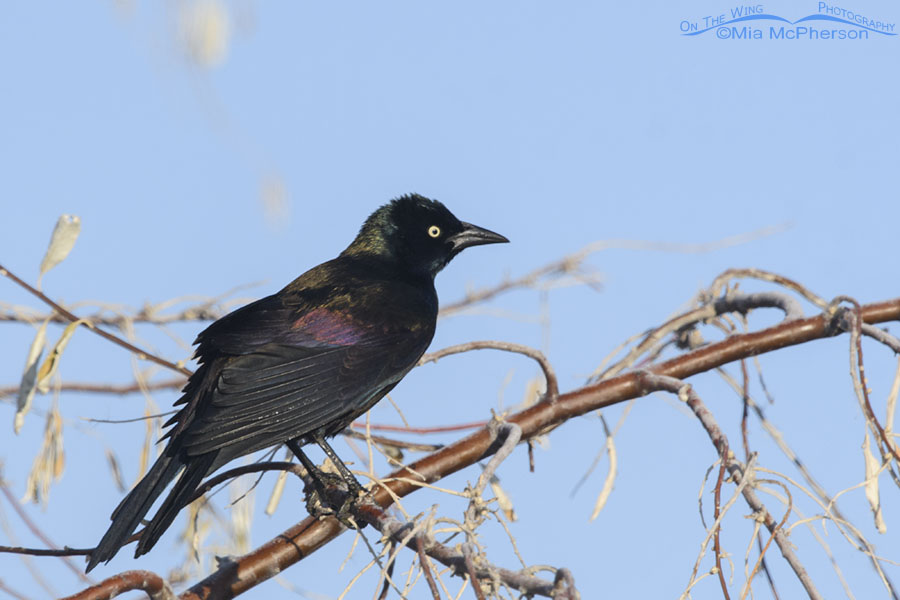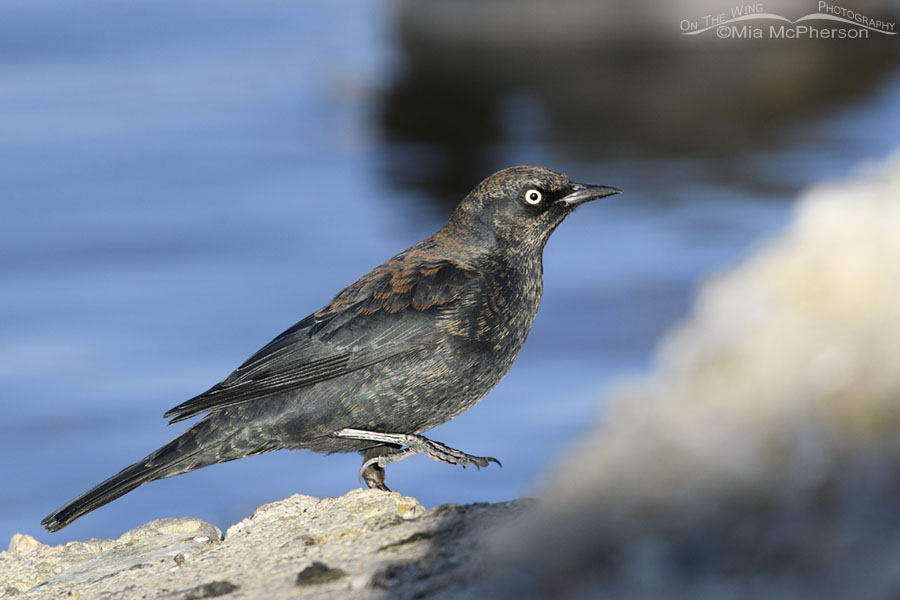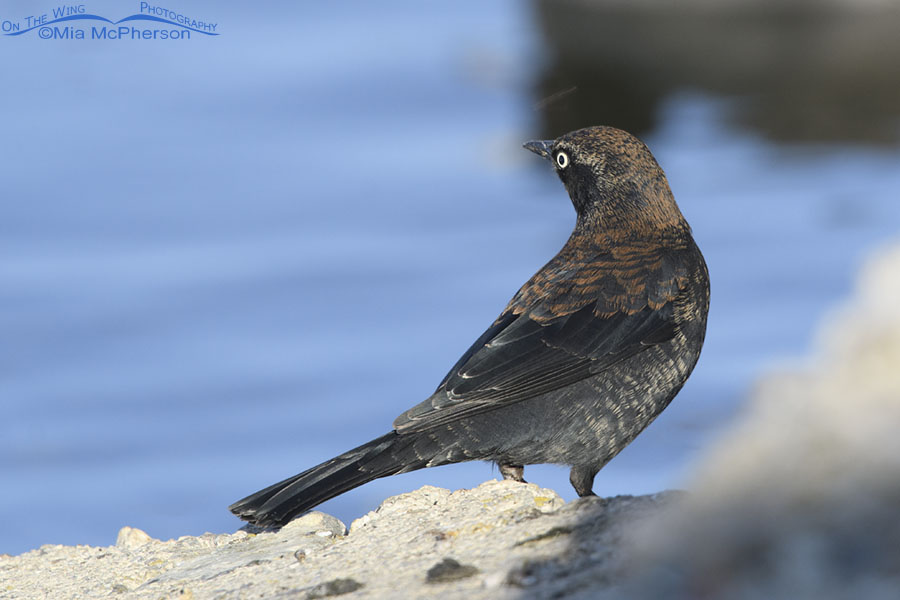 Shaking male Common Grackle – Nikon D500, f7.1, 1/1600, ISO 1000, +0.7 EV, Nikkor 500mm VR with 1.4x TC, natural light
Shaking male Common Grackle – Nikon D500, f7.1, 1/1600, ISO 1000, +0.7 EV, Nikkor 500mm VR with 1.4x TC, natural light
I’ve mentioned here that I am always looking for birds and yesterday I found out that even when I am on birds I am looking for birds.
Earlier this week I spotted a black bird preening in a Russian Olive tree next to Glover Pond at Farmington Bay WMA and as soon as I was able to get my lens on it I knew that I had found an uncommon Common Grackle. I’ve seen and photographed this species in Florida but had never seen one here in Utah.
 Adult male Common Grackle at Glover Pond – Nikon D500, f7.1, 1/2500, ISO 1000, +0.7 EV, Nikkor 500mm VR with 1.4x TC, natural light
Adult male Common Grackle at Glover Pond – Nikon D500, f7.1, 1/2500, ISO 1000, +0.7 EV, Nikkor 500mm VR with 1.4x TC, natural light
I had trouble getting sharp photos of the Common Grackle but these images are good enough for identification and documentation purposes.
Even though Common Grackles aren’t considered “rare” enough to submit to the Utah Birds Record Committee my sighting of this species still got me excited. On top of that I identified and pointed the grackle out to another person and they got a lifer bird from it.
 Adult male Rusty Blackbird at Glover Pond – Nikon D500, f7.1, 1/1000, ISO 500, Nikkor 500mm VR with 1.4x TC, natural light
Adult male Rusty Blackbird at Glover Pond – Nikon D500, f7.1, 1/1000, ISO 500, Nikkor 500mm VR with 1.4x TC, natural light
Not long after I first moved to Utah a reported sighting of a Rusty Blackbird near Glover Pond at Farmington Bay WMA got me excited and every fall and winter when flocks of blackbirds gather near the pond and the nearby farmer’s fields I have been looking through those flocks for a Rusty Blackbird. It never mattered to me whether it was a male or a female, I just wanted to see a Rusty Blackbird.
Here is a Rusty Blackbird range map, on it you can see Utah is out of range for this species.
 Adult male Rusty Blackbird in nonbreeding plumage – Nikon D500, f7.1, 1/1000, ISO 500, Nikkor 500mm VR with 1.4x TC, natural light
Adult male Rusty Blackbird in nonbreeding plumage – Nikon D500, f7.1, 1/1000, ISO 500, Nikkor 500mm VR with 1.4x TC, natural light
Yesterday morning I was photographing three Hooded Mergansers at Glover Pond near the same olive tree where I had found the Common Grackle on Monday when a mixed flock of blackbirds flew in. There were Brewer’s and Red-winged Blackbirds with a few Brown-headed Cowbirds and then one bird caught my eye because of its rusty tipped feathers. I took 31 images of the bird before it flew away.
 Back view of an adult male Rusty Blackbird in nonbreeding plumage – Nikon D500, f7.1, 1/1000, ISO 500, Nikkor 500mm VR with 1.4x TC, natural light
Back view of an adult male Rusty Blackbird in nonbreeding plumage – Nikon D500, f7.1, 1/1000, ISO 500, Nikkor 500mm VR with 1.4x TC, natural light
After eleven falls and winters I finally found my Rusty Blackbird! And it was a lifer!
Rusty Blackbirds aren’t considered rare here in Utah but they definitely are uncommon. Actually they are uncommon in their normal range now because this species is in serious decline, their populations have dropped 85% to 98% in the past 40 years. This Rusty Blackbird is an adult male in nonbreeding plumage. By the end of this winter those rusty tips on his feathers will have worn off and he will be black overall with a dull sheen.
Finding two uncommon birds this week at the same olive tree really has me buzzed and to finally see a Rusty Blackbird has made me feel like jumping over the moon.
Paying attention and knowing my birds paid off nicely this week, again, and not just for me but for the person that I pointed a lifer bird out to.
Life is good.
Mia
My thanks go out to friend, bird guide, and fellow bird photographer Mark Stackhouse for confirming my Rusty Blackbird ID. Giving credit where credit is due is important. I wasn’t 100% confident in my ID because I had zero experience with this species until yesterday.
Click here to see my Rusty Blackbird photo gallery plus facts and information about this species.


Great shots and very interesting captions. I had never known about Rusty Blackbirds until this post. Thanks Mia.
The Rusty Blackbird is beautiful!
Awesome! We have had 2 breeding pairs of Common Grackles in Eastern Idaho come each May. They would leave our Juniper trees in August for other locales. Where do you think the Rusty Blackbird originated?
Very nice! Do the black bird ever crossbreed creating a hybrid?
I had to laugh when I scanned my email for your blog, I read your tittle as “Finding Two Unicorns……” Now that will be a find!
April, I did some research and in the Icterid family it looks like orioles hybridize along with Eastern and Western Meadowlarks and one very old possible case of a grackle hybridizing with a Red-winged Blackbird are about it.
And now I can’t look at the title of this post without seeing “unicorns”, LOL LOL
Congratulations! I’m transfixed by the Rusty Blackbird’s eye. California is completely out of their range, so I thank you for sharing this beauty.
What an excellent week.
Especially love the 3rd photo – the rusty blackbird stepping out! I’ve never seen these guys before. Really beautiful in a subtle sort of way.
Thanks Mia
Great photos. I saw my first Rusty Blackbird earlier this fall. Like you, I have been looking & waiting.
I hope your going back to the same Russian Olive tree for a third !!